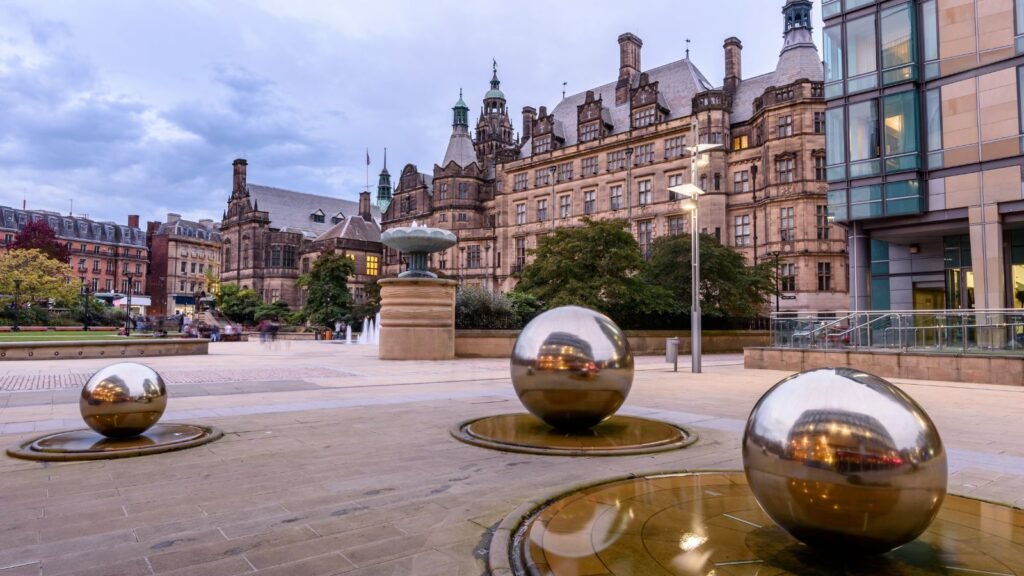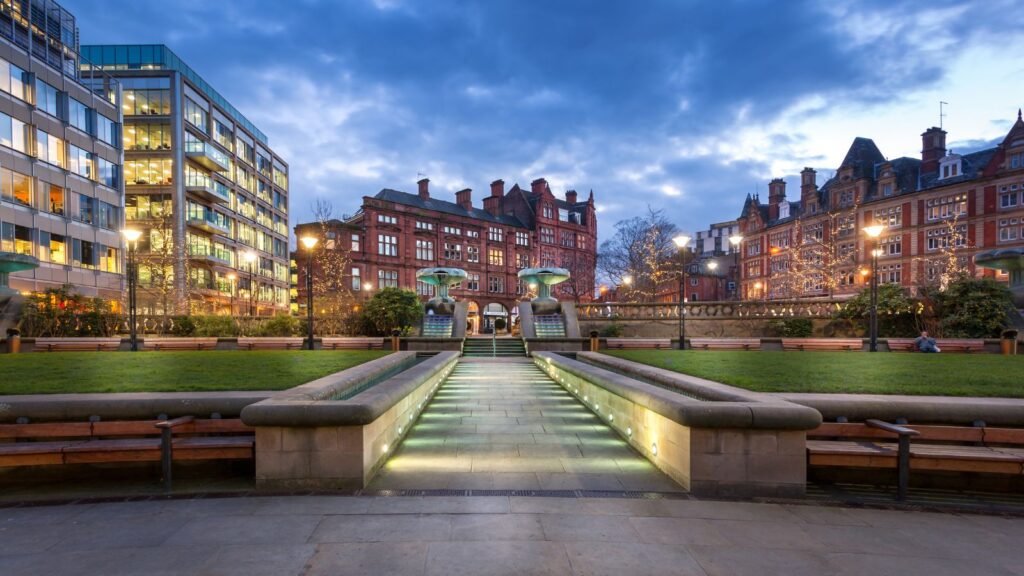Two hours in Sheffield might not sound like much, but this city has a knack for cramming centuries of steel, culture, and independent spirit into bite-sized urban pockets. It’s the kind of place where you can wander past industrial relics, lush green gardens, Victorian pubs, modern street art, and still have time for a pork sandwich. Wear sensible shoes. This is Yorkshire, and pavements don’t always care about your ankle stability—or your dignity.
Start at the train station, which is actually a decent welcome mat thanks to the steel water feature outside. It’s oddly mesmerising—part fountain, part futuristic sculpture, and possibly the city’s most Instagrammed object after an unusually symmetrical sandwich from Tamper Coffee. Walk slowly uphill (yes, it’s a bit of a slog) along Howard Street. This brief cardio session will reward you with views of the Sheffield Hallam University campus, where architecture students loiter outside red brick buildings as if brooding over a Bauhaus crisis or the price of oat milk.
Turn left at Arundel Gate and pass the brutalist dream that is the Sheffield Crucible Theatre. This is where world snooker gets very serious every spring. You’ll likely see tourists trying to peer inside hoping for a glimpse of a table or, failing that, a moody BBC camera crew whispering about century breaks. Behind it sits the Lyceum Theatre, which looks like it tried to escape to the West End but got distracted by Henderson’s Relish and decided to stay. If there’s time and something’s on, get a ticket—Sheffield does theatre like it does everything else: creatively, enthusiastically, and with a pint during the interval.

Drift through Tudor Square, named rather optimistically since very little about it is Tudor. Continue up Norfolk Street and catch your breath at the Peace Gardens. They’re an oddly serene oasis in the middle of the city, flanked by fountains, statues, and the grand Town Hall that manages to look both majestic and permanently confused. If the sun’s out (a rare but sacred event), you’ll spot locals stretched out like lizards, sipping coffee from wherever had the least intimidating queue. It’s a scene of civic relaxation, broken only by toddlers chasing pigeons and students in search of phone signal.
From here, saunter into the Winter Garden. Now this one is a genuine showstopper. A soaring glasshouse filled with palm trees, ferns, and the occasional lost office worker eating a sandwich. It smells like botanical textbooks and slightly warm humidity, and there’s often a pensioner sketching something ambiguous in the corner. It’s free, which in today’s economy feels like witchcraft. Adjacent sits the Millennium Gallery—small but mighty. Expect steel heritage, metalwork that looks like it could double as jewellery or a medieval weapon, and rotating exhibitions that bounce between the quietly profound and the gloriously odd.

Exit through the gallery’s side door and you’re back on Arundel Gate. Cross over to the Sheffield Institute of Arts, a neoclassical beauty in its past life as a post office. Now it’s full of ideas, installations, and students experimenting with angles, lighting, and their student loans. Peer through the windows—there’s usually something going on, from textile design to art that looks like it might also be furniture.
Head north along High Street toward Fargate. This stretch of pavement is classic Sheffield: a mix of chain stores, buskers with wildly variable talent levels, and teenagers with suspiciously large hoodies. Dodge the charity muggers and try not to get lured into Greggs unless you’re emotionally ready for a steak bake. Keep going until you hit the Cathedral Church of St Marie—unapologetically Gothic and wonderfully dramatic. Step inside for a blast of calm air and coloured light. The stained glass is sublime, and the silence is always welcome.
Take a detour through Chapel Walk, one of Sheffield’s oldest pedestrian lanes. Lined with indie shops and second-hand bookshops, it smells faintly of candle wax and forgotten vinyl. It’s the sort of place where you might buy a handmade notebook, a badge with obscure political references, and a three-layer cake slice that defies logic. Don’t rush—it’s a time capsule with Wi-Fi.
From here, head west to Division Street. It’s where Sheffield’s indie identity gets louder. Expect vegan bakeries with exposed brick, retro furniture shops, tattoo parlours with impeccable taste, and a few record stores run by people who probably met Jarvis Cocker once. Pop into Mooch or Syd & Mallory for clothing that says “I once had a dream in technicolour denim.”
The street art here deserves a moment. It’s not graffiti—it’s city storytelling, painted in neon. You’ll find everything from surrealist owls to cheeky commentary on capitalism. Some pieces are huge and demand attention. Others you only spot if you stop and tilt your head, like you’re considering becoming an art critic.
If the clock’s kind, duck into the Forum. It’s half café, half bar, and all Sheffield. You’ll find tables strewn with laptops, people who claim to be freelance but haven’t typed anything in hours, and groups debating whether oat milk really makes a flat white better. The courtyard hums with conversation, clinking glasses, and the occasional guilty look from someone who promised themselves they’d only stay for one.
Once re-caffeinated or gently tipsy, walk a bit further to Devonshire Green. It’s technically a park, though it feels more like an open-air urban living room. There’s grass, yes, but also ramps for skaters, benches full of thinkers and daydreamers, and enough view of the surrounding hills to remind you that Sheffield is framed by nature, even when it’s buried under concrete. On sunny days, this space becomes a democratic free-for-all: students revising (sort of), kids chasing dogs, and musicians who may or may not be in tune.
Carry on through to the top of the Moor, where the shiny new builds sit alongside a distinctly old-school vibe. Head inside the Moor Market—an absolute feast for the senses. It’s Sheffield at its most honest and unpolished. Butchers with impeccable Yorkshire banter, fishmongers laying out mackerel like it’s art, and stalls offering everything from handmade soap to mountains of olives to world cuisine cooked with real affection. Grab a snack. Or three. Maybe a pork pie, some falafel, or a samosa that burns your tongue in a good way.
On your way out, stop by the neighbouring shops. There’s an odd sense of community here—locals actually chat in queues, kids wave to market traders, and you’ll hear at least one stallholder shouting, “Two for a fiver, love, and I’ll throw in one more ‘cos it’s you.”
Two hours in Sheffield gone. You’ve walked a loop through Sheffield’s many moods: steel and steam, glass and green, grit and whimsy. It’s not one of those cities that shouts at you. It lets you come closer, peer into its quirks, and maybe fall a little bit in love before you even realise it. Now go get that pint. You’ve earned it.
